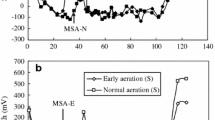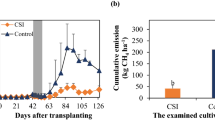Abstract
Treated wastewater (TWW) irrigation has been recommended as an environmentally friendly agricultural practice and has been applied in many countries for decades. The effects of wastewater irrigation on rice yield and quality, as well as on the environment, with particular focus on greenhouse gas emissions from paddy fields with municipal wastewater irrigation, have gained substantial attention. In this study, bench-scale experiments were conducted in two cultivation seasons where seedlings of Bekoaoba, a large-grain high-yield rice variety, were transplanted and irrigated with TWW without fertilization. A control experiment was performed to simulate the cultivation conditions of normal paddy fields. The study aimed to quantify the effects of TWW irrigation on rice yield and quality, in addition to CH4 and N2O emissions. The highest rice yield (10.4 t ha−1) and protein content in brown rice (13.8%) was achieved when the soil was repeatedly subjected to bottom-to-top TWW irrigation without any synthetic fertilizer. Bottom-to-top TWW irrigation decreased CH4 emissions by up to 95.6% when compared with tap water irrigation, whereas bottom-to-top and top-to-top TWW irrigation increased N2O emissions by 5 and 15 times, respectively. Bottom-to-top irrigation of TWW could be considered a promising solution for reducing greenhouse gas emissions as TWW irrigation resulted in a lower combined global warming potential than tap water irrigation. Further, bottom-to-top irrigation of TWW produced less CH4 and N2O than top-to-top irrigation.





Similar content being viewed by others
Data availability
Available.
Abbreviations
- EC:
-
Electrical conductivity
- GHG:
-
Greenhouse gas
- MSD:
-
Midsummer drainage
- ORP:
-
Oxidation-reduction potential
- SPAD:
-
Soil plant analysis development
- TN:
-
Total nitrogen
- TWW:
-
Treated wastewater
- WWTP:
-
Wastewater treatment plant
References
Bao Q, Huang Y, Wang F, Nie S, Nicol GW, Yao H, Ding L (2016) Effect of nitrogen fertilizer and/or Rice straw amendment on methanogenic Archaeal communities and methane production from a rice paddy soil. Appl Microbiol Biotechnol 100(13):5989–5998. https://doi.org/10.1007/s00253-016-7377-z
Chen Kuo-Cheng, Lin Ying-Feng. 1992. Inhibitory effect of ionic nitrogen oxides on methanogenesis of methanol in methanogenic sludge authors and affiliations. In Proceedings of Asia-Pacific Biochemical Engineering, 839–42. Tokyo
Chung BY, Song CH, Park BJ, Cho JY (2011) Heavy metals in brown rice (Oryza Sativa L.) and soil after long-term irrigation of wastewater discharged from domestic sewage treatment plants. Pedosphere 21(5):621–627. https://doi.org/10.1016/S1002-0160(11)60164-1
FAO. 1985. Water Quality for Agriculture. FAO IRRIGATION AND DRAINAGE PAPER. 29 Rev. 1
Fried M, Zsoldos F, Vose PB, Shatokhin IL (1965) Characterizing the nitrate and ammonium uptake process of Rice roots by use of N15 labelled NH4NO3. Physiol Plant 18:313–320
Gaihre YK, Wassmann R, Tirol-Padre A, Villegas-Pangga G, Aquino E, Kimball BA (2014) Seasonal assessment of greenhouse gas emissions from irrigated lowland rice fields under infrared warming. Agric Ecosyst Environ 184:88–100. https://doi.org/10.1016/j.agee.2013.11.024
Hanjra MA, Blackwell J, Carr G, Zhang F, Jackson TM (2012) Wastewater irrigation and environmental health: implications for water governance and public policy. Int J Hyg Environ Health 215(3):255–269. https://doi.org/10.1016/j.ijheh.2011.10.003
Homer CD, Pratt PF (1962) Methods of analysis for soils, plants and waters. Soil Sci 93(1):68
Hou AX, Chen GX, Wang ZP, Van Cleemput O, Patrick WH (2000) Methane and nitrous oxide emissions from a rice field in relation to soil redox and microbiological processes. Soil Sci Soc Am J 64(6):2180–2186. https://doi.org/10.2136/sssaj2000.6462180x
IPCC (2013a) “Climate change 2013: the physical science basis. Contribution of Working Group I to the Fifth Assessment Report of the Intergovernmental Panel on Climate Change.” Edited by V. Bex and P.M. Midgley (eds.) Stocker, T.F., D. Qin, G.-K. Plattner, M. Tignor, S.K. Allen, J. Boschung, A. Nauels, Y. Xia. Cambridge University Press, Cambridge, United Kingdom and New York, NY, USA. https://doi.org/10.1017/CBO9781107415324.018
IPCC (2013b) Climate change 2013 - the physical science basis. Intergovernmental Panel on Climate Change 446:727–728. https://doi.org/10.1038/446727a
IPPC. 2007. Mitigation of climate change: contribution of working group III to the fourth assessment report of the intergovernmental panel on climate change. Intergovernmental Panel on Climate Change
Kampschreur MJ, Temmink H, Kleerebezem R, Jetten MSM, van Loosdrecht MCM (2009) Nitrous oxide emission during wastewater treatment. Water Res 43(17):4093–4103. https://doi.org/10.1016/j.watres.2009.03.001
Minamikawa K, Tokida T, Sudo S, Padre A, Yagi K (2015) Guidelines for measuring methane and nitrous oxide emissions from rice paddies by a manually operated closed chamber method. National Institute for Agro-Environmental Sciences, Ibaraki, Japan
Liu G, Yu H, Ma J, Xu H, Wu Q, Yang J, Zhuang Y (2015) Effects of straw incorporation along with microbial inoculant on methane and nitrous oxide emissions from rice fields. Sci Total Environ 518–519:209–216. https://doi.org/10.1016/j.scitotenv.2015.02.028
Markwell J, Osterman JC, Mitchell JL (1995) Calibration of the Minolta SPAD-502 leaf chlorophyll meter. Photosynth Res 46(3):467–472. https://doi.org/10.1007/BF00032301
Masto RE, Chhonkar PK, Singh D, Patra AK (2009) Changes in soil quality indicators under long-term sewage irrigation in a sub-tropical environment. Environ Geol 56(6):1237–1243. https://doi.org/10.1007/s00254-008-1223-2
Meijide, A, C Gruening, I Goded, G Seufert, and A Cescatti. 2016. Water management reduces greenhouse gas emissions in a Mediterranean rice paddy fi eld. “Agriculture, Ecosystems and Environment” 238: 168–78. https://doi.org/10.1016/j.agee.2016.08.017
Muramatsu A, Ito H, Sasaki A, Kajihara A, Watanabe T (2015) Cultivation of rice for animal feed with circulated irrigation of treated municipal wastewater for enhanced nitrogen removal: comparison of cultivation systems feeding irrigation water upward and downward. Water Sci Technol 72(4):579–584. https://doi.org/10.2166/wst.2015.251
Ndour NYB, Baudoin E, Guissé A, Seck M, Khouma M, Brauman A (2008) Impact of irrigation water quality on soil nitrifying and total bacterial communities. Biol Fertil Soils 44(5):797–803. https://doi.org/10.1007/s00374-008-0285-3
Nyomora, Agnes MS. 2015. Effect of treated domestic wastewater as source of irrigation water and nutrients on rice performance in Morogoro, Tanzania. J Environ Waste Manag, no. 2
Pham DD, Cai K, Phung LD, Kaku N, Sasaki A (2019) Rice cultivation without synthetic fertilizers and performance of microbial fuel cells ( MFCs ) under continuous irrigation with treated wastewater. Water (Switzerland) 11(1516):1–15
Pham DD, Kurashima S, Kaku N, Sasaki A, Jian P, Watanabe T (2017) Bottom-to-top continuous irrigation of treated municipal wastewater for effective nitrogen removal and high quality rice for animal feeding. Water Sci Technol Water Supply 18(4):1183–1195. https://doi.org/10.2166/ws.2017.190
Pham, Dong Duy, and Toru Watanabe. 2017. Municipal wastewater irrigation for rice cultivation. Edited by Suren Kulshreshthat and Amin Elshorbagy. Current Perspective on Irrigation and Drainage. 1st ed. Legal Deposit, Croatia: Intech. https://doi.org/10.5772/711
Riya S, Muroi Y, Kamimura M, Zhou S, Terada A, Kobara Y, Hosomi M (2015) Mitigation of CH4 and N2O emissions from a forage rice field fertilized with aerated liquid fraction of cattle slurry by optimizing water management and topdressing. Ecol Eng 75:24–32. https://doi.org/10.1016/j.ecoleng.2014.11.034
Rogan N, Serafimovski T, Dolenec M, Tasev G, Dolenec T (2009) Heavy metal contamination of paddy soils and rice (Oryza Sativa L.) from Kocani field (Macedonia). Environ Geochem Health 31(4):439–451. https://doi.org/10.1007/s10653-008-9197-2
Singh A, Dubey SK (2012) Temporal variation in methanogenic community structure and methane production potential of tropical rice ecosystem. Soil Biol Biochem 48:162–166. https://doi.org/10.1016/j.soilbio.2012.01.022
Thu, Nguyen Ngoc. 2001. Urbanization and wastewater reuse in peri-urban areas: a case study in Thanh Tri district, Hanoi City. IWMI Working Paper, no 30: 16–17. http://www.iwmi.cgiar.org/Publications/Working_Papers/working/WOR30.pdf
Wang, Chun, Derrick Y. F. Lai, Jordi Sardans, Weiqi Wang, Congsheng Zeng, and Josep Peñuelas. 2017. Factors related with CH4 and N2O emissions from a paddy field: clues for management implications. PLoS One 12 (1): e0169254. https://doi.org/10.1371/journal.pone.0169254
Watanabe T, Mashiko T, Maftukhah R, Kaku N, Pham DD, Ito H (2016) Nitrogen removal and power generation from treated municipal wastewater by its circulated irrigation for resource-saving rice cultivation. Water Sci Technol 75(4):898–907. https://doi.org/10.2166/wst.2016.572
Weller S, Kraus D, Ayag KRP, Wassmann R, Alberto MCR, Butterbach-Bahl K, Kiese R (2014) Methane and nitrous oxide emissions from rice and maize production in diversified rice cropping systems. Nutr Cycl Agroecosyst 101(1):37–53. https://doi.org/10.1007/s10705-014-9658-1
Win KT, Nonaka R, Win AT, Yu S, Toyota K, Motobayashi T (2013) Effects of water saving irrigation and rice variety on greenhouse gas emissions and water use efficiency in a paddy field fertilized with anaerobically digested pig slurry. Paddy Water Environ 13(1):51–60. https://doi.org/10.1007/s10333-013-0406-y
Xu S, Hou P, Xue L, Wang S, Yang L (2017) Treated domestic sewage irrigation significantly decreased the CH4, N2O and NH3 emissions from paddy fields with straw incorporation. Atmos Environ 169:1–10. https://doi.org/10.1016/j.atmosenv.2017.09.009
Yang QW, Lan CY, Wang HB, Zhuang P, Shu WS (2006) Cadmium in soil-rice system and health risk associated with the use of untreated mining wastewater for irrigation in Lechang, China. Agric Water Manag 84(1–2):147–152. https://doi.org/10.1016/j.agwat.2006.01.005
Yang S, Peng S, Xu J, Luo Y, Li D (2012) Methane and nitrous oxide emissions from paddy field as affected by water-saving irrigation. Phys Chem Earth 53–54:30–37. https://doi.org/10.1016/j.pce.2011.08.020
Yoon CG, Kwun SK, Ham JH (2001) Effects of treated sewage irrigation on paddy rice culture and its soil. Irrig Drain 50(3):227–236. https://doi.org/10.1002/ird.27
Zou J, Huang Y, Jiang J, Zheng X, Sass RL (2005) A 3-year field measurement of methane and nitrous oxide emissions from rice paddies in China: effects of water regime, crop residue, and fertilizer application. Glob Biogeochem Cycles 19(2):1–9. https://doi.org/10.1029/2004GB002401
Zou J, Liu S, Qin Y, Pan G, Zhu D (2009) Sewage irrigation increased methane and nitrous oxide emissions from rice paddies in Southeast China. Agric Ecosyst Environ 129(4):516–522. https://doi.org/10.1016/j.agee.2008.11.006
Funding
This study was supported by the Ministry of Land, Infrastructure, Transport, and Tourism (MLIT) of Japan through the Gesuido Academic Incubation to Advanced (GAIA) project, and by the Ministry of Education, Sports, Culture, Science, and Technology (MEXT) of Japan through the Center of Community (COC) project. This study was conducted as a part of the activities of the Institute for Regional Innovation, Yamagata University.
Author information
Authors and Affiliations
Contributions
Conceiving experiment: Dong Pham Duy, Toru Watanabe.
Conducting experiment: Dong Pham Duy, Agnes Hoki Briliana Suhono, Nobuo Kaku, Shuhei Masuda, Fumiaki Takakai.
Analyzing the data: Dong Pham Duy.
Preparing the manuscript draft: Dong Pham Duy.
Revising the manuscript: all the authors
Corresponding author
Ethics declarations
Competing interests
The authors declare that they have no competing interests.
Ethics approval, consent to participate and publish
This manuscript is the original work of authors, which has not been previously published elsewhere.
The manuscript reflects the authors’ own research and analysis in a truthful and complete manner.
The manuscript properly credits the meaningful contributions of co-authors.
The results are appropriately placed in the context of prior and existing research.
All sources used are properly disclosed (correct citation).
All the authors have been personally and actively involved in substantial work leading to the paper, and will take public responsibility for its content.
Additional information
Responsible Editor: Philippe Garrigues
Publisher’s note
Springer Nature remains neutral with regard to jurisdictional claims in published maps and institutional affiliations.
Rights and permissions
About this article
Cite this article
Pham, D.D., Suhono, A.H.B., Kaku, N. et al. Methane and nitrous oxide emissions from paddy fields with no fertilizer use under continuous irrigation with treated municipal wastewater. Environ Sci Pollut Res 28, 23420–23431 (2021). https://doi.org/10.1007/s11356-020-12328-0
Received:
Accepted:
Published:
Issue Date:
DOI: https://doi.org/10.1007/s11356-020-12328-0




